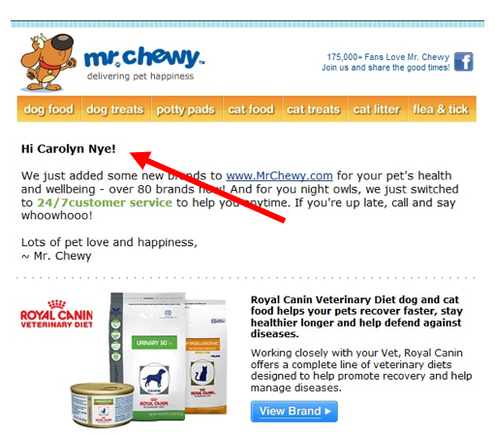An email marketing message needs to be relevant to its recipients to achieve maximum results. Relevancy can be a simple as inserting the recipient’s name in the subject line or salutation. But it can be much more dynamic than that, too. It can include recommendations based on past purchases and browsing habits, or even date-triggered messages.
Below are three easy tools that you can implement to increase the relevancy of your email marketing communications.
Basic Personalization
The biggest misnomer about personalization is that it’s simply inserting person’s first name in the subject line or within the body of an email, as in “Dear So and So.” Although this is a basic example of personalization, it can include any element in your database that is unique to that recipient. Personalization, in its basic form, is really using any detail you may know about a person to append into the email body or subject line that is specific to that individual. This can be the town or city he or she resides in. It can be his or her birthday, a pet’s name, or a specific purchase in the past. The more you know about an individual, the more you can personalize the email to tailor to his or her personality, which increases the relevancy of the email.
This email from a pet supplier includes a personalized salutation: "Hi Carolyn Nye!." Enlarge This Image
Enlarge This Image
Almost every email service provider will have basic personalization capabilities — to insert any single element of your database into the body or subject line of your email. It is always important to have a default value in case the data element is missing in any of your records to avoid display errors. For example, use a default value like “Customer” for first name. That way, if the person’s first name is missing from your database, it will display “Customer” instead of simply a blank space.
Dynamic Content
Dynamic content is a tool in which large elements of the email creative content are changed based on complex rules. The content within the email is, in fact, dynamic — based upon criteria determined within your database. With dynamically generated content, an email message is created just once, but it may render in dozens of different ways depending on the rules you have specified. Not every email service provider offers dynamic content capabilities. Traditionally, larger top-tier providers will have more sophisticated capabilities, along with an easy-to-understand interface to set up the dynamic content.
Consider this example. Say a fitness chain with 20 different locations wants to send out one email to offer a free first month’s membership. The chain would also like to direct recipients to the location that is nearest them geographically by highlighting the address, picture, and unique link directing to that specific location’s website. Instead of sending 20 different creative messages and segmenting the list in 20 ways, this can be easily accomplished using dynamic content rules and simply sending one email.
The graphic designer or email marketing manager will need to design the email in such a way that one block of HTML can be swapped out for another, leaving the remaining template intact. A small block of code will need to be created with all the different elements and loaded into the dynamic content interface you utilize with your email service provider. Next you simply need to map out your rules to ensure the right content is displayed to the right recipient. Some ESPs will have a comprehensive testing screen that will allow you to preview the email and apply your different rules, to make sure the content is displaying correctly.
This email from Amazon contains dynamically-inserted product recommendations based on the recipient’s browsing history. Enlarge This Image
Enlarge This Image
Date-Triggered Campaigns
Taking personalization to the next level, we can design campaigns that are entirely personalized. A good example is a “Happy Birthday” campaign. If you store a contact’s birthday information, this campaign is easy to set up, and it runs automatically. The email itself is personalized based on the deployment date as a set number of days prior to the birthday date in the database. Most ESPs will have functionality to set up an automatic recurring deployment that runs every day. This email can be further personalized to have the recipient’s first or last name or other information. Moreover, personalized campaigns that are date-triggered can include events like anniversaries or the last purchase date, for “We Miss You” campaigns.
Summary
Both personalization and dynamic content are tools within the email marketer’s toolbox that create relevancy. Remember, personalization and dynamic content are only as effective as the quality of your database and the information you know about your recipients. Maintaining a complete and up-to-date database will allow you to fully utilize personalization and dynamic content.





